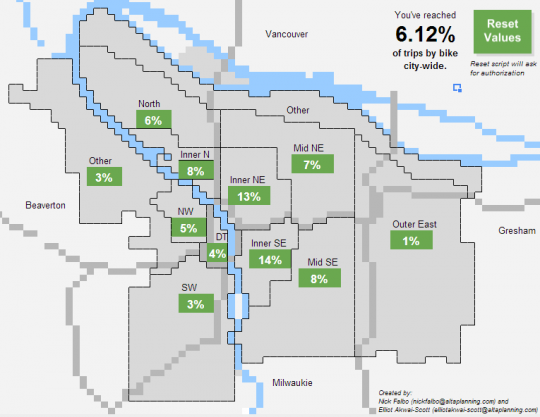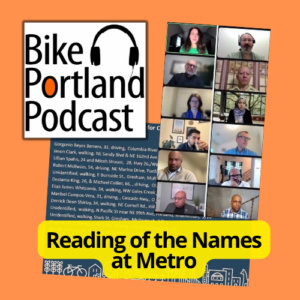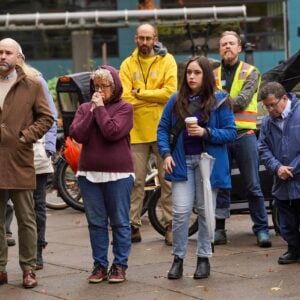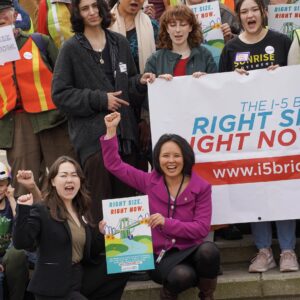Kicking off NW Portland Week.
No part of Portland has more untapped biking potential than its smallest quadrant.
Northwest Portland is, in ways we’ll explore this week, already the city that much of Portland dreams of becoming. It’s income- and age-diverse, rich with jobs at every skill level and businesses of every size. Its streets are relatively safe; aside from the outer industrial reaches of U.S. 30, it’s only seen 14 traffic fatalities in 10 years. According to the city’s annual community survey, no quadrant reports less trouble with speeding traffic.
Northwest Portland is a paradise of proximity. But fewer people bike here than in St. Johns, North Tabor or Foster-Powell.
And people are certainly eager to become northwest Portlanders. The quadrant has been growing faster than any other. Iain MacKenzie, a northwest Portlander who publishes the development website NextPortland.com, calculates that the district has added or is preparing to add 5,980 new homes since 2010. He points out that the population of the Census tract along the western side of the Pearl District, beneath and on each side of Interstate 405 as it climbs to the Fremont Bridge, has risen 90 percent since 2009.
But only about 6 percent of the residents of that neighborhood bike to work — the same share as in the entire city of Portland.
Advertisement
The next tract west is 5 percent. The tract to the north, above Thurman Street, is 4 percent. The thousands of residents there have approximately the same probability of getting around by bike as those at NE 89th and Glisan, or SE 52nd and Flavel, or the neighborhoods just north of downtown Vancouver, Wash.
Portland is betting its future on being able to reduce drive-alone cars down to 40 percent of all citywide traffic in the next 15 years. But here in northwest Portland’s paradise of proximity, 40 percent of commutes still happen in cars. Transit and walking are already popular, with about 17 percent of commutes each. It’s biking that is failing to realize its potential.
The clever Google spreadsheet game created in 2014 by Nick Falbo and Elliot Akwai-Scott of Alta Planning + Design, which challenges users to get Portland to its 25 percent biking target, is the best illustration we’ve seen of how unusually low northwest Portland’s biking rate is:

(Click to enlarge, or click here to play the spreadsheet-based game.)
Here’s another way to look at it: northwest Portland has approximately the same amount of biking that inner southeast Portland did in 1990.
In other words, this is a problem that Portlanders know how to solve.
All this week we’ll be reporting about the ways Portlanders have been, and will continue to, solve the problem of biking here in northwest. Stay tuned.
— Michael Andersen, (503) 333-7824 – michael@bikeportland.org
BikePortland can’t survive without subscribers. It’s just $10 per month and you can sign up in a few minutes.








Thanks for reading.
BikePortland has served this community with independent community journalism since 2005. We rely on subscriptions from readers like you to survive. Your financial support is vital in keeping this valuable resource alive and well.
Please subscribe today to strengthen and expand our work.
The reason so few bike in NW is that you really don’t need to. It’s easily the most walkable quadrant – nearly everything is within walking distance. For longer trips, Streetcar works well – especially for people who work downtown. Plus, who wants to deal with biking downtown when you can just walk or take public transport? When I lived in Goose Hollow (not technically NW but close enough; I was two blocks south of Burnside) I almost never biked downtown. It was much easier and safer to walk. I did bike to work at the edge of NW because it meant a 10 minute ride instead of a 30 minute walk.
Portland would do much better if instead on investing in bike infra in NW, created disincentives to driving via parking removal, car-free streets, movable bollards, diverters, etc. Remove most of the cars and NW becomes a biking paradise.
It takes 30 minutes to walk from 25th and Overton to Union Station. 20 minutes by transit (if you time it right). Six minutes by bike. And lots of people need to go further than Union Station!
Yes, Northwest is great for walking and decent for transit, and I think you’re right that a few disincentives to drive would go a long way. But people won’t accept those disincentives until we making biking a much more viable alternative; it’s the mode that is the single best substitute for driving.
The streets in NW are already set up for easy biking. Nearly every street is two-way, two lane. All we need is less cars on them and they become more attractive to cycling. Compare NW to Central Amsterdam – very few streets actually have dedicated bike infra on them, but there are so few cars that biking is really easy and safe. Less motor traffic also speeds up public transport.
I think the primary problem here is too many people trying to drive around a dense and highly walkable neighborhood. Remove the cause of this problem and everything else falls into place.
“All we need is less cars on them”
Read the Greenway Report and you’ll see why the streets are not set up for easy biking. Every single one of them (besides a couple block stretch of Marshall) has way too many cars and the city has done nothing to alleviate this. Every single one.
Yes, this is why we need neighborhood-wide diversion.
For me, even one diverter at NW 24th and Kearney would be a nice token of good faith from PDOT. Somebody made the point that Couch Park keeps car traffic out of NW 20th more or less (It’s only semi-pervious to people on bikes). While I’m asking, how about a diverter at NW 20th and Overton?
I’ve long believed that NW 23rd should be closed to passenger cars but that’s rich fantasy.
SE,
Of course, you know the greenways in NW are the ‘legacy’ variety, like Tillamook, and have yet to be upgraded to ‘greenway’ standards, yes? Also, the assessment report identified those needs.
My thoughts in 2009 on why I walk more than bike within the neighborhood. In 2016 my choice of 5-minute destinations is even richer!
https://pdxplanningcommissioner.com/2009/12/03/walkscore-and-the-5-10-20-minute-neighborhood/
As a person who lived in NW and now lives in NE, my wife and I also rarely biked in NW, but it’s our primary mode of transportation in NE. In NW, we could walk or take the tram to pretty much everything we wanted and, while it’s true that it would be faster to bike, we often walked anyway since psychologically everything didn’t seem that far away. Also, due to the number of cars and frequency of stop signs and lights, biking feels a bit tedious on the west side because you’re constantly having to stop and go.
do you want to lock your bike up in a rack at Union Station? I’m certainly not that interested in having my bike stolen…
that’s the main reason I don’t bike into downtown…
I’ll be downtown all week at a conference and I’m taking the bus because there’s no way I’m leaving my bike locked on the street for 8 hours…
it’s 45 minutes by bus and 35 minutes by bike (all downhill from SE)… add in time locking up and securing my components, having to lug around tools/helmet, and I’m just not interested in taking the bike…
is that just for the rich people?
Wow, can people stop with this line of thinking already…
More people work in Northwest Portland than live there.
One more time…MORE PEOPLE WORK IN NORTHWEST PORTLAND THAN LIVE THERE.
http://explorethepearl.com/downloads/PDBA_market_analysis_memo_7-8-2015.pdf
If SE Clinton Street deserves decent bike facilities Adam, then NW commuters and visitors deserve decent bike facilities too.
Clinton Street has no bike facilities. The only infrastructure on that street is designed to limit motor traffic to make cycling more attractive. I’m saying do the same in NW but on a neighborhood-wide scale. This could work given the high density of the area.
I’m one of those people who (used to, anyway) work in NW and live outside the neighborhood. When I lived in Goose Hollow, I rode down 20th because it had the least cars (due to the diverting nature of Couch Park). After I moved to SE I rode down the riverwalk to avoid Naito. Major streets at the edges of the neighborhood (Burnside and Naito) should get protected cycleways, but if we limit motor traffic inside the neighborhood, the need for dedicated infra is reduced.
Thanks for your perspective. It’s all about what is appropriate given the street context. With respect to diversion on greenways, I consider that to be as much of a bicycle facility as a protected bike lane on a major arterial. I just get tired of people repeating the viewpoint that people in NW can walk anywhere as if that justifies bike mode share being mired in the single digits.
True, but I consider heavy motor traffic to be a detriment to city life, not just cycling. Reducing the amount of cars on neighborhood streets benefits everyone not in a car. Kids can play in the streets, walking becomes more comfortable, residents enjoy less noise pollution, and yes, biking becomes safer and more enjoyable. I see diverters not just as a bike facility, but as a device to improve urban livability.
I would not want to ride in that area. I am always in constant fear my bike would get stolen…especially in downtown/NW area. Walk or transit for sure.
I disagree. Having lived in NW Portland for ~4 years, I found bicycling to downtown, PSU, and even the eastside to be insanely convenient and time-saving.
Actually, bike commuting from NW Portland is what got me on a carfree diet!
I work in NW, and commute into it from SW. The commute is harrowing. There is a massive wave of car commuter traffic flowing West to East in the AM, and East to West in the PM. Every cross street is like frogger during the commute times. Drivers frequently drive 50 mph on Burnside West of 21st only to stop @ 23rd and 25th. Apart from rush hours, people are all on their phones, running stop signs, and circling the block to look for parking. More needs to be done to discourage driving. The major employers need to be on board with reducing driving but they have done nothing of the sort recently. The Pearl is becoming a self contained city, and Slabtown will likely follow suite. People already avoid the Pearl if they are driving because it is slow and harder to park a car, and it is thriving. All of NW will soon be like this, much to the chagrin of drivers who refuse to adapt.
Demand-based parking meters in the entire district would be a start.
I think that the core of NW portland would give us the best opportunity in our city to do some really bold thinking and go virtually car free, From Burnside to Thurman, and 13th to 25th lets go beyond our dream of protected bike lanes and constrain cars to just a few arterials. Perhaps allow them only on Glisan, Everett, 18 and 19th and make the rest car free. Use the money saved and subsidize cargo bike deliveries for business and perhaps allow a special travel lane to the hospital. Most of this area was not built around the motorcar and can easily return to its former glory. Parking and driving in this area is already a joke, lets just put it out of it’s misery and move in to the future.
For people who are “interested but concerned”, safety is the #1 barrier to bicycling. NW has a great safety record, but most people perceive riding in mix traffic as unsafe and uncomfortable. To get more people to bike, there needs to be more comfortable and safe bike facilities. Car-free streets is one option, and there many other ways to make our streets “feel” safer.
Another important factor is changing the incentive structure of different transportation modes. As long as we continue to subsidize and under-price parking and driving, people will continue to be encourage to drive. NW has done a better job in managing on-street parking and reducing parking minimums than other parts of the city, but to get the targeted mode split by 2040 we are going to need more progressive transportation policies.
I guess I’m pretty much done arguing with people that the point of bike infrastructure is to give people alternatives to getting around by car, not to force people out of their cars for the sake of doing so. It’s a good thing I don’t have a problem admitting when I’m wrong.
I’ll just have to tell my wife that her RA is going to render her housebound a few years before we planned. Since I’m strong, I can do all the errands by bicycle by myself (for now).
Who am I kidding, Increasing property values and Hales’ new plan to foreclose on people who can’t pay their property taxes will take our house, and force us to a car dependent rural backwater anyway.
Is it “forc[ing] people out of their cars for the sake of doing so” or “somewhat reducing the vast amount of public land, public dollars, and restrictions on private development devoted to making driving extremely convenient?” The things that are proposed in City policy documents seem far more like the latter than the former to me.
Motor vehicle use wouldn’t be supported to the extent it is, if it weren’t crucial to the viability of the economy. Bikes aren’t able to transport people and goods with the versatility and efficiency that motor vehicles are able to.
I’d guess that so many of the people living in the Pearl, don’t bike for practical purposes, because they don’t have to. Why should they bother with the hassle of biking, when they have before them, the ease of walking that part of town…if they want the exercise…and other mass transit options, including personal motor vehicle ownership, which by the looks of the Pearl, it seems they definitely have the money for.
From personal experience, it’s not that difficult to ride a bike in the Pearl, street car tracks and all…but it’s not much fun. Residential streets in quieter NW Portland, west of the 405 are better for riding…also a more enjoyable neighborhood to walk in.
Making motor use more difficult, as a means towards getting more people to ride bikes, is a funny strategy.
It could be either, neither, or both; it’s hard to say what the intent of a policy is without actually look at it.
NW Portland has many amenities but I only visit a few times a year because my partner does not enjoy riding in the lane with cars. The argument that a dense urban neighborhood full of commercial establishments does not need dedicated bike infrastructure because many locals walk is deeply flawed, IMO. My inner SE neighborhood is far more walkable (for me) than any neighborhood in NW Portland and has far more cycling infrastructure.
Part of the problem is that the city has little experience designing effective greenways in dense urban environments with a lot of pedestrian traffic. You may rail against the NIMBYs in Buckman and HAND, but greenways in the Portland context tend to thrive in single-family, lower-density neighborhoods. Much less pedestrian activity, for instance, and less stop signs to interrupt travel. When you bike on Johnson or Flanders or Marshall in NW, the land-use context is identical to the major streets.
I agree that comfortable Greenways in the NW will require more extensive traffic calming (hopefully the Clinton project serves as a test case). However, the inner SE also has OK bike lanes that feed efficiently and somewhat comfortably into those Greenways (Burnside –> Ankeny; Hawthorne –> Harrison/Clinton). Inner NW lacks decent Greenways and good connections to other neighborhoods.
Make sure to wear spandex and hi-vis then race through the throngs of people waiting in line at the organic sno-cone truck. Yeah, that’s right, I’m the Sunday Parkways Grinch
I was involved in the initial bikeway plan in NW more than a decade ago. The greenways in the neighborhood aren’t significant improved, because there weren’t strong standards for greenway improvements (we still called them bike boulevards back then) at the time.
But was has also happened is that development has overwhelmed some of the greenways. The new traffic signal at 23rd and Raleigh basically signals that Raleigh is on its way to becoming an East/West collector in the north end of the neighborhood. That role is in direct conflict with being a greenway.
Chris,
TriMet also plans to run the extension of Line 10 on Raleigh to serve the Conway development. PBOT is looking into moving the greenway designation one block north, to Savier.
Savier has a lot of potential in the future, but the problem right now is that it doesn’t exist as a street between NW 21st and 22nd. That section of the road will be built out as part of the Con-way Blocks 294E and 295E development, but there’s likely two years of construction that needs to happen before that section of road is open to the public.
It’s a shame that the traffic signal at 23rd & Raleigh (which mostly car drivers) was built to coincide with the opening of New Seasons, but nothing has been done to improve the environment for cyclists.
NW is the first stop in Portland for a lot of people. Day trippers, bridge-and-tunnel, foreign tourists, new residents.
I lived in NW for 5 yrs off-and-on. It was my first neighborhood & the place I habitually bounced back to between addresses. I used my car there so infrequently it grew moss.
NW is densely packed, well connected to transit, close to downtown & the hills, & lots of fun to visit/work/live. And still so leafy & green. A quick scan of CL shows me you can still find apartments there for $1000/mo (barely) so it might still be the youngest neighborhood in town.
How we present NW is pretty hugely How the World Sees Portland. We should do it up proper in all the fanciest bike infra. I want the world to see Portland as a place where your bike is a Freedom Ticket and your car is a mossy hassle.
Yes, if you care how the world sees portland.
I suppose it depends on whether your goal is to win awards and bring in tourist dollars, or help the existing residents.
No reason why we can’t do both. The Pearl has the highest percentage of affordable housing in the city.
Does it? I can think of several neighborhoods that would seem to have a higher percentage of affordable housing.
Not much to say here that hasn’t been said. I think if there is one thing I can add to this discussion is more observation than experience. I was vetted in SE before I started commuting over here so I was strong, smart and confident. Take that away and there’s no way I would have considered it. Here’s why: bike lanes. Where are they? They only seem to exist in places where green and casual riders would NOT be advised to go (NW Naito, NW Everett, 17/18th). When I talk to people who aren’t into rallying into high speeds and spandex at 8am, they’re the type who want to cruise at low speeds in bike lanes. Additionally, the streets vary drastically from safe to very unfriendly to bikes so you have to know how you’re getting where you’re going. Simply having trolly tracks is enough to scare casual riders, combine that with busy intersections and rush hour traffic and you’re just scaring people for fun now, really?! Can someone find a way to engineer intersections so cyclists can maneuver safely without getting tracked?
I think 405 remains a barrier for bikes (if only we had used that Sauvie Island Bridge) and it makes driving so much easier. The death of the Mt. Hood Freeway helps make it harder to penetrate SE Portland quickly with a automobile. So NW Portland needs to be come that much more convenient to bike in order to attain the same numbers. I may be wrong but I also think NW has an older population that I am guessing does not bike as much (I hope I am wrong about that)
Does anyone know if the bike commute statistic for NW is impacted by a low incidence of commuters? If there is a high proportion of NW residents who are retired or otherwise not working (seems possible?), what’s the denominator for the 6% bike commuters? Is it the total population (which would lower the %), or just those who commute (which would raise the %)?
Follow the link to the “spreadsheet-based game”
And then click on the back end data tab. The percentage is of the employed resident population, not the total population. Data is from Census ACS surveys. And this is just for commute trips, not all trips.
http://factfinder.census.gov/bkmk/table/1.0/en/ACS/12_5YR/B08301/1400000US41051004500|1400000US41051004700|1400000US41051004800|1400000US41051004900|1400000US41051005000|1400000US41051005200
This should give you the census tracts for NW and the means of transportation to work table. 5 year ACS 2012 to 2014 transit mode share has decreased from 20.1% to 19.0%, walk mode share has decreased from 21.4% to 19.4%, work at home mode share increased from 8.2% to 8.7%, and bike mode share has increased from 5.4% to 6.5%. All changes are well within the margin of error, not sure how seriously to take them.
cycling in nw Portland is easy, it just lacks those huge neighborhood corridors that are easy to ride down like the east side has. we have a few, 22nd, 20th, but for the most part its just a dense grid like any other city. distances are short and the terrain is flat. if anything its more suitable for a certain type of bike, not a certain type of infrastructure. upright city bikes instead of full kit road bikes seem to be the best option. I liken NW to a beehive. I live up there but do all my riding on the east side or sometimes up in the hills. at the end, I return to the hive. its not a destination to ride to, its a place to leave and return to.
The terrain is most certainly not flat. It’s a slow, steady uphill from I-405 to Westover, where the grade proceeds to go up a literal cliff.